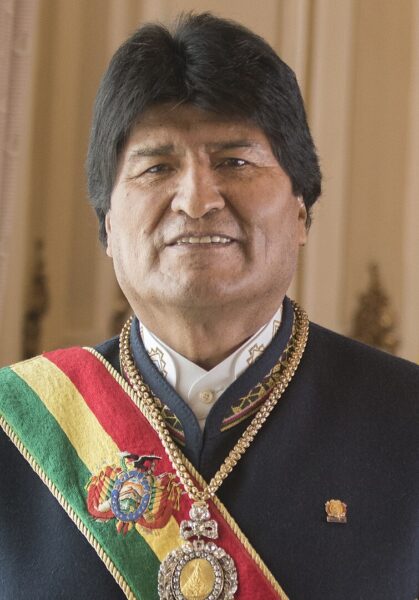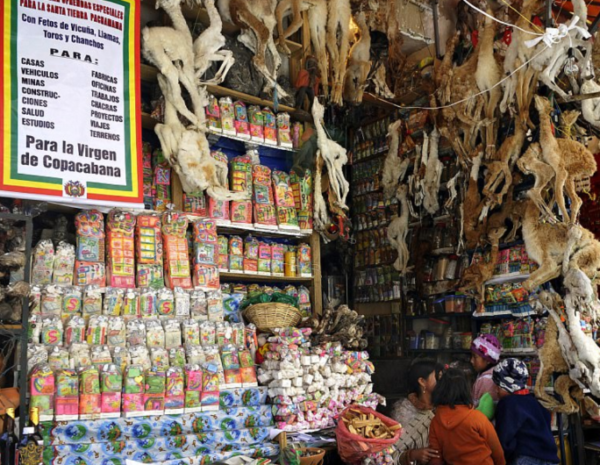Bolivia’s first indigenous president.
As for Evo Morales, he was elected to his first five-year term in 2006 and, among his early acts as president, was convening a constitutional convention. That convention drafted a new constitution that was ratified in 2009. Among the changes from the old document, were the adoption of a new name “Plurinational State of Bolivia” and the recognition of 37 official languages. Among the compromises was the retention of Sucre as the country’s nominal Constitutional capital and home to the country’s Supreme Court.
While the linguistic recognition is important, it must be acknowledged that two-thirds of the population speaks Spanish and all legal and official documents issued by the State, including the Constitution, the main private and public institutions, the media, and commercial activities, are in Spanish. Quechua (21% of the population) and Aymara (15%) are the two most widely spoken indigenous languages.

[Photo of Evo Morales from Wikipedia By EneasMx – Own work, CC BY-SA 4.0.]
Both Morales and the reforms he promoted had great support when he was first elected. However, he has gradually taken steps to consolidate his hold on power and is attempting to be re-elected for a fourth term, in spite of a section of the 2009 Constitution that presidents can serve no more than one consecutive term. I will leave it to you to discover the ways in which he has managed to circumvent this constitutional restriction (if your curiosity so prompts you) but will add that, according to Berner and our local guide, there is a growing faction within the population particularly in the urban centers (less so in the rural areas where we saw many signs of support for him) who are worried and dismayed by Morales’ actions.
Mercado de las Brujas (not as scary as it sounds).
Just a few hundred meters from our hotel in central La Paz – less than five minutes walk – is the famous Mercado de las Brujas or Witches Market. It’s a place frequented by both tourists and Bolivians.
Only three countries in South America (Uruguay, Argentina, and Chile) have populations that are majority European. In other countries, such as Peru, the combination of indigenous Amerindians and mestizos constitutes the demographic majority. Only one, however, has a majority of indigenous people and that is Bolivia. Thus, it should come as no surprise that, even at this early stage of our trip, we had seen an admixture of European and indigenous cultural and religious practice and iconography but nowhere had we seen the prevalence of native culture that we saw in La Paz and, more specifically in el Mercado de las Brujas.
The name likely derives from the prevalence of icons European Christians perceived as purely superstitious (Of course, there were no perceptions of superstitious elements attached to their icons.), the various potions said to bring good fortune, love, or protection from evil spirits, and other native concoctions intended for medicinal use.
One might wonder what do the Bolivians buy and why do they buy it. (The photo above is not necessarily what the natives buy. Though it’s possible that the Aymara or some of the other indigenous people might purchase some of these items or spell boxes that come in different sizes and colors and contain pre-made spells in them, I think these particular items are more intended to catch the eyes of tourists who might want to look away from some of the less appealing items within.)
If you see someone at the market buying sweets, alcohol, or coca it’s likely that they are miners who make frequent offerings to the gods both to make up for the riches they take from the earth but also to keep them safe from the dangers of their profession.
Among the more exotic offerings in the market you can find naked statues of couples, phallus-shaped black candles, owl feathers, armadillos, snakes, condor feathers, dried frogs, and turtles. Each serves a different ritual purpose. The stuffed toads are used to attract fortune or money, the condor feathers favorable travel, and the turtle to assure good health.
There are also yatiris. These are indigenous wise men believed to be seers and who read coca leaves to determine a person’s destiny. One English speaking vendor I found told me, “It all depends on the faith you bring to this street.” Given my life view, I concluded none of these potions or amulets would work for me.
We can’t leave the market without addressing the prevalence of llama fetuses known as sullus.

These serve several purposes. For example, some workmen make certain there is one on site to ward off accidents. But there is a much more important use for the llama fetuses.
(Before you turn apoplectic, the Aymara and other people of the region only use naturally aborted fetuses and these are fairly common. Because they lack the physical capacity to have a large litter, pregnant llamas abort fetuses regularly throughout their gestation period. These natural miscarriages can occur from points very early in the pregnancy until the fetus is nearly at full term. Thus, while some of the fetuses you see in the market are from those early stages, others look like baby llamas complete with fur. Nature has a way of finding balance and has atoned for the llama’s inability to bear a large litter in this case by allowing them to become pregnant again in as little as two weeks after giving birth.)
Regarding that more important use for the llama fetuses, whenever Bolivians are constructing a new building or house, they bury a llama fetus under the foundation as a gift to Pachamama (Mother Earth). This sacrifice, one variation of a ceremony called ch’alla, is meant to provide protection, good luck, and prosperity for both the residents and the builders.
It’s time to move on from el Mercado de las Brujas and we’ll continue exploring La Paz in the next post.
